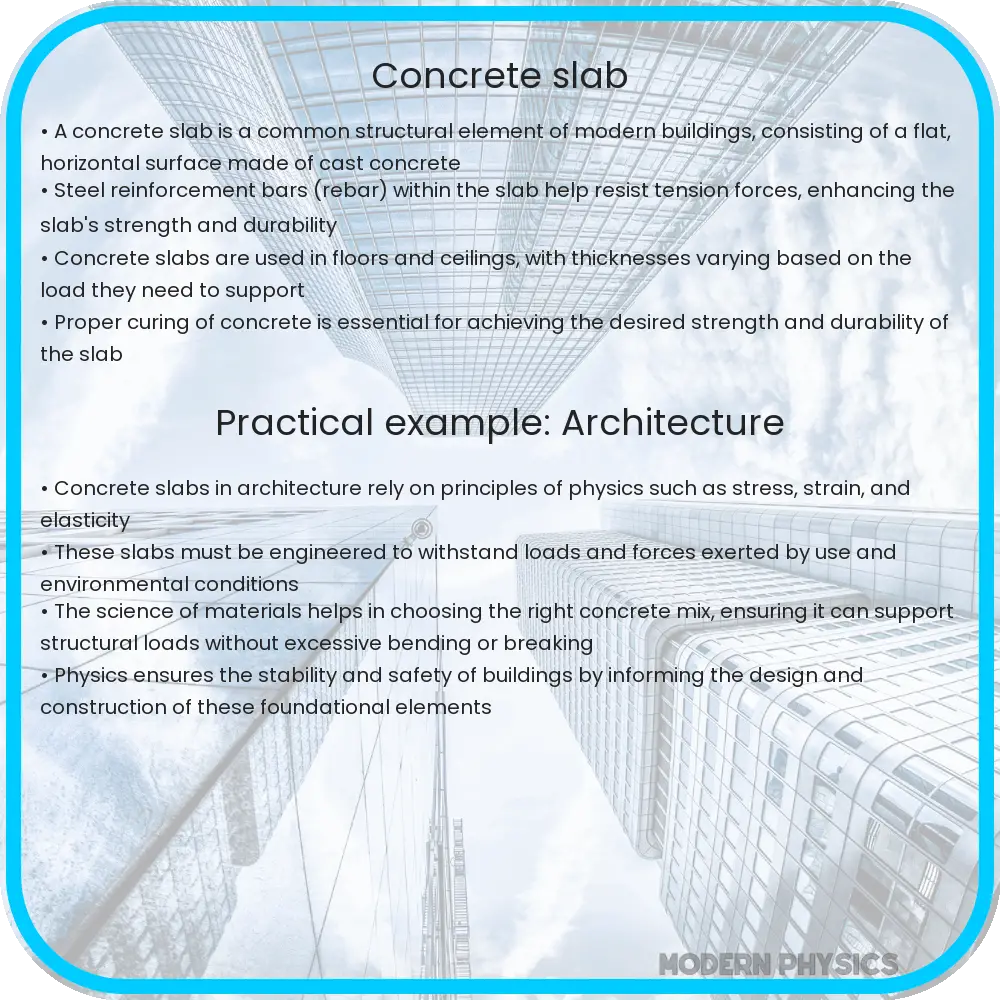Explore the essentials of concrete slab design, focusing on strength, load-bearing, stability, and the latest techniques and standards.

Understanding Concrete Slab Design: Essentials of Strength, Load-Bearing, and Stability
Concrete slabs form the foundational element in modern construction, offering a balance of strength, load-bearing capacity, and stability. The design of a concrete slab is crucial in ensuring the safety and longevity of a structure. This article explores the key aspects of concrete slab design, focusing on its strength, load-bearing capabilities, and overall stability.
1. Compressive Strength of Concrete
The compressive strength of concrete, denoted as ‘fc,’ is a primary factor in slab design. This strength is the measure of the concrete’s ability to withstand loads without failure. It’s typically measured in pounds per square inch (psi) or megapascals (MPa). The choice of concrete mix, which includes the proportions of cement, water, aggregates, and admixtures, significantly influences this strength.
2. Thickness and Reinforcement
The thickness of a concrete slab is directly related to its load-bearing capacity. Thicker slabs can bear more weight, making them suitable for industrial or commercial buildings. Reinforcement, often in the form of steel bars (rebar), is incorporated within the slab to enhance tensile strength, helping the concrete withstand tensile stresses and prevent cracking under load.
3. Soil and Foundation Interaction
A crucial aspect of slab design is understanding the interaction between the soil and the foundation. The type of soil and its bearing capacity determine the load distribution and the potential for settlement or shifting. Proper soil analysis and foundation design are imperative to prevent uneven settling, which can lead to structural damage.
4. Environmental Considerations
Environmental factors like temperature changes, moisture, and chemical exposure can impact the durability and performance of concrete slabs. Expansion joints are often used to accommodate thermal expansion and contraction, while waterproofing and protective coatings can safeguard against moisture and chemical damage.
5. Load Types and Distribution
Concrete slabs must be designed to handle various types of loads, including dead loads (permanent/static loads like the weight of the structure itself) and live loads (temporary or dynamic loads like furniture, people, and vehicles). The distribution of these loads affects the stress experienced by the slab and dictates reinforcement placement and slab thickness.
By considering these factors, engineers and architects can design concrete slabs that not only support the intended loads but also resist environmental stresses, ensuring the safety and longevity of the structure.
6. Deflection Control and Serviceability
Deflection control is a vital aspect of concrete slab design, ensuring that the slab does not bend or deform excessively under load. Excessive deflection can lead to cracking and compromise the slab’s structural integrity. Engineers use deflection limits and reinforcement strategies to maintain the serviceability of the slab over its lifespan.
7. Design Codes and Standards
Adherence to design codes and standards is essential for safe and effective slab construction. Codes such as the American Concrete Institute (ACI) guidelines provide specifications for minimum thickness, reinforcement requirements, and load calculations. These standards ensure that the design is consistent with safety regulations and industry best practices.
8. Advanced Techniques and Materials
Advancements in concrete technology have introduced new materials and techniques in slab design. High-performance concrete, fiber reinforcement, and lightweight aggregates are examples of innovations that enhance the strength and durability of concrete slabs while optimizing material usage and cost-effectiveness.
9. Software and Modeling Tools
Modern engineering employs software and modeling tools for accurate and efficient slab design. These tools enable precise calculations, stress analysis, and visualization of load distribution, significantly improving the design process’s accuracy and efficiency.
Conclusion
The design of concrete slabs is a complex and critical process in construction, demanding a deep understanding of material properties, environmental factors, and load-bearing requirements. By considering factors like compressive strength, thickness, reinforcement, soil interaction, and adherence to design standards, engineers can ensure the stability and longevity of concrete slabs. Innovations in materials and the use of advanced software tools further enhance the capability to design slabs that are not only structurally sound but also cost-effective and environmentally sustainable. As construction technology evolves, the principles of concrete slab design continue to be a cornerstone in the creation of durable and safe structures, reflecting the ever-growing demands of modern architecture and engineering.
